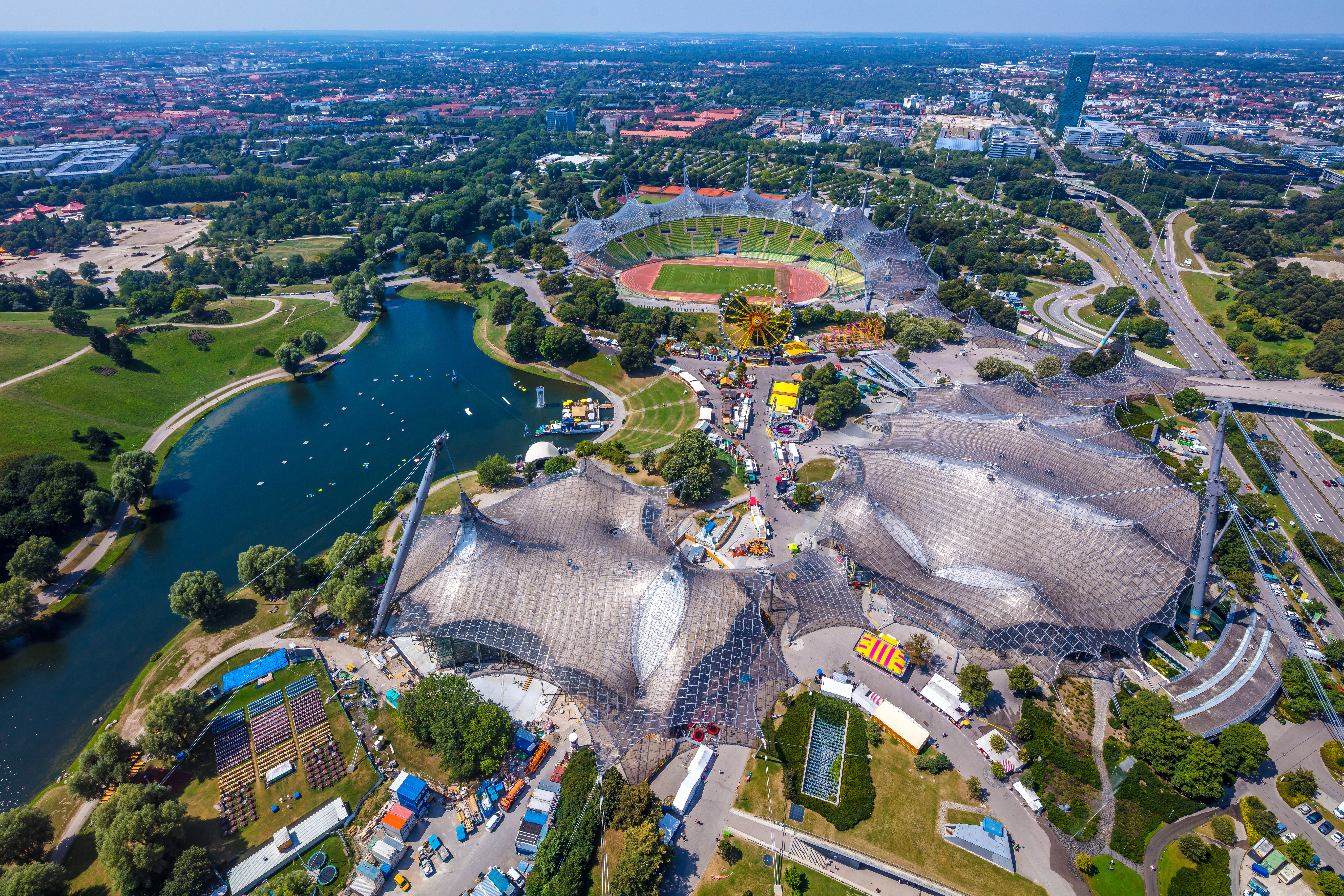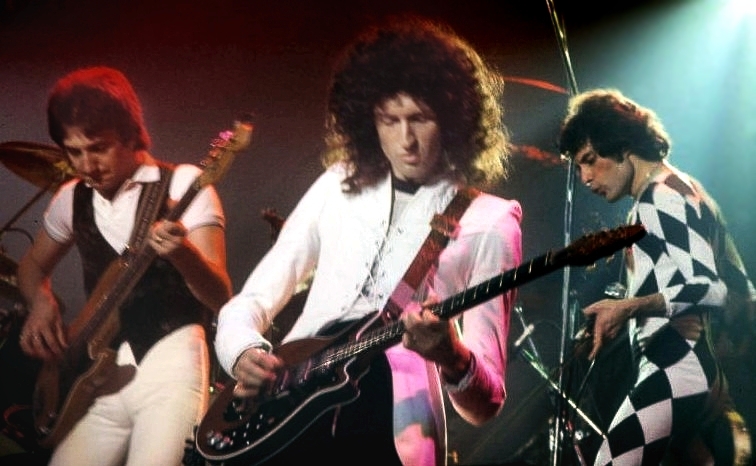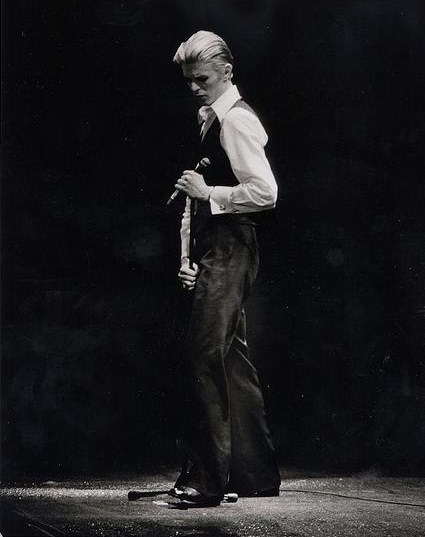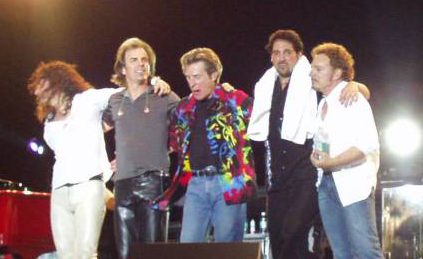|
Olympiahalle
Olympiahalle is a multi-purpose arena located in Am Riesenfeld in Munich, Germany, part of Olympiapark. The arena is used for concerts, sporting events, exhibitions or trade fairs. The seating capacity for the arena varies from 12,150 up to 14,000. History In the past, it served as a part-time home for the defunct ice hockey team EC Hedos München. Olympiahalle opened in 1972 and was the venue for gymnastics and handball events at the 1972 Summer Olympics. The current seating capacity of 15,500 was set after a massive overhaul was completed in 2009. A new VIP area, a restaurant and an underground second arena ("Kleine Olympiahalle") with a capacity of up to 4,000 was integrated in the new complex. The stage area was also rebuilt, which contributed to the increased seating capacity and at the same time allowed faster access for stage crews. By February 2020, the air conditioning, other technology and lighting were modernised, and the original look from 1972 in the hall itsel ... [...More Info...] [...Related Items...] OR: [Wikipedia] [Google] [Baidu] |
Handball At The 1972 Summer Olympics
Handball at the 1972 Summer Olympics was the second appearance of the sport at the Olympics, returning to the Olympic program after a 36-year absence. The competition was for men only and it was contested by sixteen teams. The teams were split into four groups of four teams each. Each team played every other team in its group. The lowest team in group A played the lowest in group B while the lowest in groups C and D played each other. The winners of those games played each other for 13th and 14th places, while the losers played each other for 15th and 16th. The third-ranked teams in groups A and B also played each, as did those in groups C and D. Again, the winners of those games played each other, this time for 9th and 10th places. The losers played for 11th and 12th places. The top two teams in each group advanced to the main round. Those from groups A and B became group I while those from groups C and D became group II. Another round-robin was played within those grou ... [...More Info...] [...Related Items...] OR: [Wikipedia] [Google] [Baidu] |
Olympiapark, Munich
The Olympiapark (English: Olympic Park) in Munich, Germany, is an Olympic Park which was constructed for the 1972 Summer Olympics. Located in the Oberwiesenfeld neighborhood of Munich, the Park continues to serve as a venue for cultural, social, and religious events, such as events of worship. It includes a contemporary carillon. The Park is administered by Olympiapark München GmbH, a holding company fully owned by the state capital of Munich. Location and structure The use of the term ''Olympiapark'' to designate the overall area has prevailed as a semiofficial practice, but no official name for the entire area exists. The general area comprises four separate sub-areas:Otto Haas, Wolfgang Kösler (Red.): Offizieller Olympiaführer der Spiele der XX. Olympiade München 1972. Organisationskomitee für die Spiele der XX. Olympiade München 1972. Atlas Verlag, München 1972. * Olympic Area: Includes the Olympic sports facilities such as the Olympic Stadium and the Olympic Hall wit ... [...More Info...] [...Related Items...] OR: [Wikipedia] [Google] [Baidu] |
Am Riesenfeld
Am Riesenfeld is the westernmost of the three subdistricts of the Munich city district 11 Milbertshofen-Am Hart. Location North of the Petueltunnel route, borders the district Am Riesenfeld which is further separated by the Korbinianstraße or Schleißheimer Straße to the east, to the neighboring district Milbertshofen. In the north, it is separated from the district Lerchenau by the railway tracks or a part of the Wilhelmine-Reichard-Straße, in the west it is separated by the Landshuter Allee or the abandoned tracks of the Moosach district. In the southwest, the boundary of the district Am Riesenfeld to the district of Neuhausen-Nymphenburg runs along the ''Willi-Gebhardt-Ufer'' to the ''Spiridon-Luis-Ring'', which forms the western boundary of the ''Olympia Park'' on the western border of the larger ''Olympiaberg'', and then along to Ackermannstraße. In the south, the border with Schwabing-West runs along the curve of the Ackermannstraße to Winzererstraße, which togethe ... [...More Info...] [...Related Items...] OR: [Wikipedia] [Google] [Baidu] |
1972 Summer Olympics
The 1972 Summer Olympics (), officially known as the Games of the XX Olympiad () and commonly known as Munich 1972 (german: München 1972), was an international multi-sport event held in Munich, West Germany, from 26 August to 11 September 1972. The event was overshadowed by the Munich massacre in the second week, in which eleven Israeli athletes and coaches and a West German police officer at Olympic village were killed by Palestinian Black September members. The motivation for the attack was the ongoing Palestinian-Israeli conflict. The 1972 Summer Olympics were the second Summer Olympics to be held in Germany, after the 1936 Games in Berlin, which had taken place under the Nazi regime, and the most recent Olympics to be held in the country. The West German Government had been eager to have the Munich Olympics present a democratic and optimistic Germany to the world, as shown by the Games' official motto, ''"Die Heiteren Spiele"'', or "the cheerful Games". The logo of th ... [...More Info...] [...Related Items...] OR: [Wikipedia] [Google] [Baidu] |
Gymnastics At The 1972 Summer Olympics
At the 1972 Summer Olympics, fourteen different artistic gymnastics events were contested, eight for men and seven for women. All events were held at the Sports Hall in Munich from 27 August through 1 September. Format of competition The gymnastics competition at the 1972 Summer Olympics was carried out in three stages: *Competition I - The team competition/qualification round in which all gymnasts, including those who were not part of a team, performed both compulsory and optional exercises. The combined scores of all team members determined the final score of the team. The thirty-six highest scoring gymnasts in the all-around qualified to the individual all-around competition. The six highest scoring gymnasts on each apparatus qualified to the final for that apparatus. *Competition II - The individual all-around competition, in which those who qualified from Competition I performed exercises on each apparatus. The final score of each gymnast was composed of half the points ... [...More Info...] [...Related Items...] OR: [Wikipedia] [Google] [Baidu] |
The Who Tour 1980
The Who Tour 1980 was The Who's second concert tour since the death of original drummer Keith Moon, supporting their 1978 album '' Who Are You''. History Aside from six warm-up shows in Europe, the tour focused primarily on the areas of North America not covered in the band's previous tour, which had focused on the northeastern United States. The set list was very similar to what they played on that tour, save the omission of "The Punk and the Godfather", which was only performed once in 1980. "Relay" was played for the first time since their 1972 European tour, and the group also briefly resurrected " Getting In Tune" for one show during the European warm-up tour, although it did not remain in the act. Yet-unreleased songs "How Can You Do It Alone" and "Dance It Away" returned from the previous tour as well, with the latter having developed into a full song similar to the bonus track on the reissue of Townshend's 1982 solo album ''All the Best Cowboys Have Chinese Eyes''. A ver ... [...More Info...] [...Related Items...] OR: [Wikipedia] [Google] [Baidu] |
Isolar II – The 1978 World Tour
The Isolar II – The 1978 World Tour, more commonly known as The Low / Heroes World Tour or The Stage Tour,Nicholas Pegg, ''The Complete David Bowie'', Reynolds & Hearn Ltd, 2004, was a worldwide concert tour by David Bowie. The tour opened on 29 March 1978 at the San Diego Sports Arena continuing through North America, Europe and Australia before reaching a conclusion at the Nippon Budokan in Japan on 12 December 1978. Tour development and song selection Originally, Brian Eno planned to be a part of the tour band, but had to drop out due to health reasons. The band only had two weeks to rehearse for the tour. Carlos Alomar was the tour's band leader and drove the rehearsals. The set list for the performances consisted of material from the previous year's albums, '' Low'' and '' "Heroes"'', with the second half of each performance opening with a five-song sequence from ''The Rise and Fall of Ziggy Stardust and the Spiders from Mars'' album. Bowie had the band learn the entiret ... [...More Info...] [...Related Items...] OR: [Wikipedia] [Google] [Baidu] |
News Of The World Tour
The News of the World Tour was the fifth headlining concert tour by the British rock band Queen, supporting their successful 1977 album ''News of the World''. The tour spanned from 11 November 1977 to 13 May 1978 over three tour legs: North America, Europe, and The United Kingdom. Rehearsals for the tour took place at Shepperton Studios in October 1977. Overview Hot off the heels of the A Day at the Races Tour, the band retreated to Wessex Studios to record their sixth studio album, News of the World. A video shoot for the first single off the album, "We Are the Champions," was shot on 6 October 1977 at New London Theatre. Many people from the Queen Fan Club were privately invited to the event to fill up the theatre. After running through four takes of the video, the band played a short live set for the 900 person audience, which served as a warm-up gig for the tour in the coming month. The band then spent the last week of the month rehearsing for the tour, during which, News ... [...More Info...] [...Related Items...] OR: [Wikipedia] [Google] [Baidu] |
Isolar – 1976 Tour
The David Bowie Isolar – 1976 Tour was a concert tour in support of the album ''Station to Station''. It opened on 2 February 1976 at the Pacific Coliseum, Vancouver, and continued through North America and Europe, concluding at the Pavillon de Paris in Paris, France, on 18 May 1976. The tour is commonly referred to as Thin White Duke Tour, The Station to Station Tour, and The White Light Tour. History The performances began without introduction with a showing of the 1928 surrealist film by Luis Buñuel and Salvador Dalí, ''Un Chien Andalou'', which includes a famous section of a razor blade cutting into a woman's eyeball. Bowie appeared on stage immediately as the film finished, while the audience was still disoriented. The visual element of the performances incorporated banks of fluorescent white light set against black backdrops creating a stark spectacle on a stage largely devoid of props or other visual distractions. The Public Auditorium, Cleveland, Ohio performance ... [...More Info...] [...Related Items...] OR: [Wikipedia] [Google] [Baidu] |
Amigos Tour
Amigo(s) (Portuguese and Spanish for ''male friend'') may refer to: People * Carlos Amigo Vallejo (born 1934), Spanish Roman Catholic archbishop emeritus of Seville Places Facilities * Amigos School, a bilingual primary school in Cambridge, Massachusetts, U.S. * Los Amigos Biological Station, a research station in Peru * Los Amigos High School, Fountain Valley, California, U.S. Other places * Amigo, West Virginia, U.S., an unincorporated community * Los Amigos River, a river in Peru Businesses and products * Amigo (restaurant), a Hong Kong restaurant * Amigo Comics, a Spanish comic book publisher * Amigo Energy, an American retail electricity provider * Amigo Holdings, a British lender * Amigo Spiele, a German board and card game publisher * Amigo Supermarkets, a chain of supermarkets in Puerto Rico * Amigos Creations, an Indian film production company * Amigos Library Services, an American company * Isuzu Amigo, a compact SUV * IGO amigo, a version of the navigation sof ... [...More Info...] [...Related Items...] OR: [Wikipedia] [Google] [Baidu] |
Journey (band)
Journey is an American rock band formed in San Francisco in 1973 by former members of Santana, Steve Miller Band, and Frumious Bandersnatch. The band currently consists of guitarist/vocalist Neal Schon (the last original member), keyboardists/vocalists Jonathan Cain and Jason Derlatka, drummer/vocalist Deen Castronovo, bassist Todd Jensen, and lead vocalist Arnel Pineda. Journey had their biggest commercial success between 1978 and 1987, when Steve Perry was lead vocalist; they released a series of hit songs, including "Don't Stop Believin' (1981), which in 2009 became the top-selling track in iTunes history among songs not released in the 21st century. ''Escape'', Journey's seventh and most successful album, reached number one on the ''Billboard'' 200 and yielded another of their most popular singles, " Open Arms". The 1983 follow-up album, ''Frontiers'', was almost as successful in the United States, reaching number two and spawning several successful singles; it broadened ... [...More Info...] [...Related Items...] OR: [Wikipedia] [Google] [Baidu] |
Rainbow (rock Band)
Rainbow (also known as Ritchie Blackmore's Rainbow or Blackmore's Rainbow) are a British rock supergroup, formed in London and Los Angeles in 1975 by guitarist Ritchie Blackmore. Established in the aftermath of Blackmore's first departure from Deep Purple, they originally featured four members of the band Elf, including their singer Ronnie James Dio, but after their self-titled debut album, Blackmore fired these members, except Dio, recruiting new members, including drummer Cozy Powell. The band recorded their second album '' Rising'' in 1976, while ''Long Live Rock 'n' Roll'' (1978) would be the last album with Dio before he left the band to join Black Sabbath in 1979. Rainbow's early work primarily featured mystical lyrics with a neoclassical metal style, then went in a more pop-rock oriented direction following Dio's departure from the group. In 1979, Blackmore and Powell revamped the group, recruiting three new members —singer Graham Bonnet, keyboardist Don Airey and a ... [...More Info...] [...Related Items...] OR: [Wikipedia] [Google] [Baidu] |


_-_Milbertshofen_-_Am_Hart.png)




.jpg)